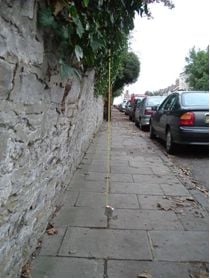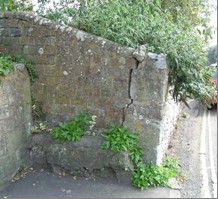EXISTING GARDEN WALLS
Building Regulations do not apply to garden walls, but: -
Garden walls may eventually collapse if they are not properly maintained. They are unfortunately one of the most common causes of death or serious injury from falling masonry. Please check your garden walls from time to time to see if any repairs are necessary, or whether they need rebuilding.
THINGS TO CHECK:
Garden walls may eventually collapse if they are not properly maintained. They are unfortunately one of the most common causes of death or serious injury from falling masonry. Please check your garden walls from time to time to see if any repairs are necessary, or whether they need rebuilding.
THINGS TO CHECK:
| 1 | Is the surface of the brickwork crumbling away? If restricted to a few bricks this may not be serious but walls can be weakened by general crumbling across either face. | ||
| | | ||
| 2 | Is the mortar pointing in good condition? If the hard surface layer can be picked out from the joint, or if the mortar can easily be scraped out with say, a door key, then this is a good indication that the wall may need repairing. | ||
| | | ||
| 3 | Is there a tree near the wall? As trees mature, there is a risk of the wall being damaged by the roots, and from wind-blown branches. Damaged sections may have to be rebuilt, perhaps with ‘bridges’ incorporated to carry the wall over the roots. Removal of large trees can also lead to problems because the soil accumulates more moisture and expands. | ||
| | | ||
| 4 | Is the wall upright? Walls leans for a variety of causes, due for example to failure below ground level caused by tree roots, a cracked drain, frost damage to the foundations or inadequate foundations. If your wall leans to an extent that could present a danger e.g. more than 30mm (half brick wall) 70mm (single brick wall) or 100mm (brick and half wall) it is recommended that expert advice is sought. This may involve checking of the wall foundations. |  | |
| 5 | Some climbing plants, like ivy, can damage walls if growth is unchecked. Consider cutting them back and supporting re-growth clear of the wall. | ||
| | | ||
| 6 | Is the top of the wall firmly attached? Brick cappings or concrete copings may be loose or there may be horizontal cracks (frost damage) in the brickwork a few courses down. Loose or damaged masonry near the top of the wall need to be rebuilt. | ||
| | | ||
| 7 | Has the wall been damaged by traffic? Minor scratch marks or scoring of the surface may obscure more significant cracks. Piers at vehicular entrance may have been dislodged by impact and be unsafe; in such cases they should be rebuilt. | ||
| | | ||
| 8 | Are there any cracks in the wall? Hairline cracks (0-2mm across) are common in walls and normally do not indicate serious problems. For wider cracks seek expert advice; some may indicate a need for partial or complete rebuilding. Seek advice on any horizontal cracks which pass right through a wall or any cracks close to piers or gates. Repointing of cracks can lead to problems. Do not repoint without establishing the cause of the cracking. |  | |
If you are concerned that a wall may be in danger of collapse, please contact a Building Control Surveyor. We will not be able to carry out repairs, but we will take action to protect the public if the wall is considered to be a dangerous structure.
Page last updated on: 09/07/2009





